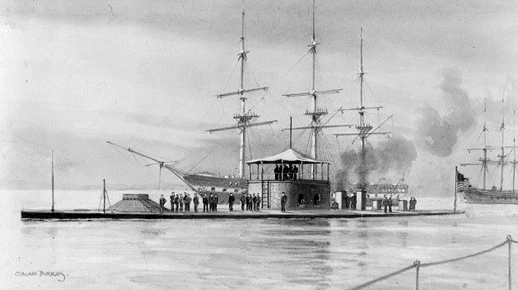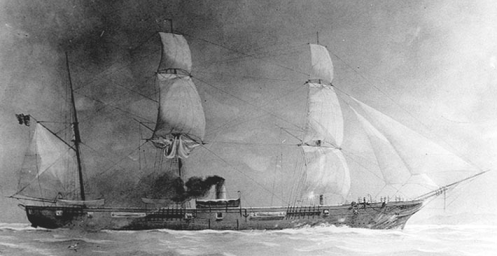|
Naval
Warfare in the American Civil War
the
first in a three part series
by
Peter Hunt
Introduction
The American Civil War is often
cited as the first "modern" war.
In many respects this description is open to argument as many of the
innovations such as rifles, breach loaders, telegraphs, railways, etc. had
played important roles in other mid 19th Century wars.
Without doubt however the war at sea marked a turning point in naval
history marking the end of the "wooden wall" line of battleships
which had held sway since the Spanish Armada and laying out the design of
the armoured, turreted, steam powered ship which dominated naval strategy
until the coming of age of the aircraft carrier in 1941.
Since the A.C.W. also marked the first successful use of the two
greatest killers of ships, the submarine and the naval mine it is safe to
say that this was the first modern naval war.
This article will cover the
technological changes and the operational aspects that made the war so
unique and also, in my opinion, make it a perfect period for wargaming,
whether you want to have an accurate recreation of a certain battle or just
a straight "set 'em up and go for it" game.
It is also a period where the wargamer's habit of mixing his hobby
with alcoholic beverages is not amiss since a fair proportion of the
participants in the real thing seem to have done much the same.
Technology
By the start of the ACW steam power
as a means of naval propulsion had been around for over 40 years, but it had
always been regarded as an auxiliary to sail power, either in the form of a
small engine to keep a sailing ship going in a calm or of steam powered tugs
to tow sailing ships in harbours and coastal waters.
The reason for this was that early engines were so inefficient that
no ship could carry the amount of coal necessary to steam large distances.
Thus navies were still tied to the strategy and tactics of sail
power.
For instance, the British fleets
that dominated the Baltic and Black Seas in the Crimean War, although
consisting in the main of steam-engined ships, were still sailing fleets at
heart and would have been familiar to Nelson or Drake.
By the 1860s however engines were rapidly becoming more efficient and
it was possible for relatively small ships to carry enough coal to get
themselves across large distances with a decent cargo.
Most ships still retained a full sailing rig but now it was the sails
that provided the auxiliary power.
Not having to rely on the wind gave
admirals much more tactical freedom but there was a strategic price to pay. In previous wars ships could stay at sea as long as their
food, water and ammunition held out. From
now on ships would require refuelling too, either at friendly ports or from
supply ships, thus the fleet train of supply vessels to keep the fighting
fleet going was born, a naval development to which the USN has always since
paid the most attention of' any major power.
The use of steam power now made it
possible to provide armour for ships to keep out shot and shell.
In the war all armour was iron and only the North had the industrial
capability to roll armour plate. The
South armoured its warships by using old railroad tracks, but as the war
progressed and the Southern railways became more and more dilapidated, even
old rails were better than none and railroad iron for warships became like
gold. Although the ACW is
remembered as being the first naval war between armoured ships it must be
said that most of the ships on both sides were unarmoured and unarmoured
ships could, occasionally, take out armoured vessels.
The South also used what I supposed would today be called
"organic" armour in that, having no shortage of King Cotton they
took to armouring their ships with bales of the stuff.
These "cotton clads" had at least some protection against
shot, but of course the cotton was highly inflammable, no small
consideration when all ships were still made of wood.

USS Monitor - watercolour by Oscar
Parkes
Improved casting techniques had,
throughout the 19th Century, made it possible to cast bigger and bigger
guns. Thus whilst Nelson 's
wooden walls would be armed with 6.4" guns firing shot of 32 lb, by the
ACW such guns would be regarded as light and most vessels would be armed
with 8" - 11" guns firing shot of 150 lb, with some carrying
15" monsters firing 300 lb shot. Thus,
for instance, David Farragut's flagship, a sloop of 21 guns, fired a heavier
weight of shot than did Nelson's "Victory" of 100 guns.
As on land many of the naval guns were also rifled. This gave improvement in accuracy but, more importantly, the
higher muzzle velocities gave much better penetration than smoothbores.
It must be stressed that much of this technology was new and
untested. The gunners were
working at "the edge of the envelope" and only trial and error
could determine the optimum charge for a gun. The "trials" often took place in the heat of battle
as gunners seeing their shot bounce off armoured opponents desperately increased the charge.
An "error" however would mean a burst gun and dead gunners,
a not infrequent occurrence.
Finally we turn to the underwater
menace. The term
"torpedo" was used in the ACW to describe any naval explosive
device and ought not to be confused with the modern, self propelled,
explosive "fish" which was not invented then.
There were basically two types of torpedo, firstly there were the
sort of things that we would now call mines, containers of explosives moored
underwater and set off by contact detonators or, again a first for the ACW,
command detonated by electricity. Since
ships of the period had little, if any, internal, water tight sub-dividing,
any hole below the waterline could prove fatal and since most of the armoured ships had very little reserve buoyancy anyway, they
could sink in seconds as a result of a mine explosion.
At best the torpedoes were unreliable and there are several recorded
incidents of ships crews hearing the snapping of detonators as they hit a
mine but no explosion resulting. Even
so, such an experience probably did little for the colour of one's
underpants.

USS Housatonic - as portrayed by
R.G. Skerrett in 1912
Spar torpedoes were explosive
charges placed on a spar clear of the bow of the ship, the idea being to
drive your ship at his and detonate the charge against his hull.
Again the effect seems to have been very variable - sometimes
devastating, frequently ineffectual. Theoretically
any ship could rig a spar torpedo although both sides had a few vessels that
used this weapon as their main armament.
The first successful submarine attack occurred when the CSS Hunley
sank the USS Housatonic. Strictly
speaking, the Hunley was a submersible and made the attack on the surface
for the very sensible reason that she had already sunk twice with all hands
when carrying out diving trials. As
it happened, however, the wash from her bow torpedo explosion swamped the
Hunley and she sank again. After
this the Confederates called it a day with submarine development but the way
ahead bad been shown.

Confederate submarine H.L. Hunley
- a detail from R.G. Skerrett's painting of 1902
The Theatre of Operations
Simply put, the naval aspects of
the ACW took place in three spheres of operations, coastal, riverine and
oceanic. The coastal sphere can also be neatly divided into the East
Coast and Gulf of Mexico theatres and the conflicts on the rivers basically
took place an the Mississippi and her tributaries in the west and the James
in the east. In the coastal and
riverine theatres, a small draught was a considerable advantage although the
Mississippi was navigable to ocean going shipping for several hundred miles.
Shallow draught ships were at a considerable disadvantage in normal
seas and, if armoured or either badly designed or hastily converted, were
often little more than death traps for their crews in open water.
The war on the high seas was
basically a matter of commerce raiding and blockade running by the
Confederates, and the Union taking countermeasures.
There were several engagements between Confederate raiders and Union
warships on the high seas and these, with the substitution of steam for sail
power, were akin to the sort of single ship duels that had been a feature of
the Anglo-American war of 1812. Confederate
raiders were active in all the great seas of the world except, perhaps, the
Mediterranean.
In the next part of this article I
shall go on to discuss the way the war was fought and to look into the
wargaming possibilities.
back
to american civil war go to part two
|